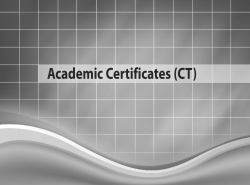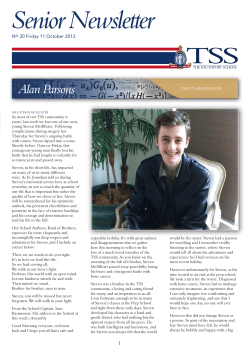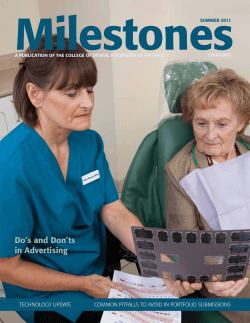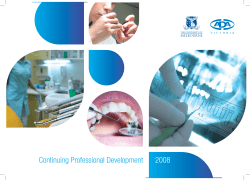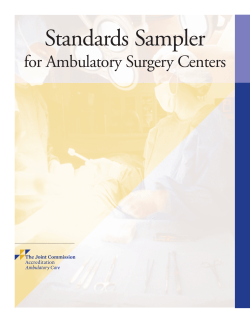
2014 Oregon Dental Conference
2014 Oregon Dental Conference Steven Beadnell, DMD & Brett Ueeck, DMD, MD Course 4101: “Medical Emergency Update” Thursday, April 3 1- 5 pm Medical Emergencies Update 2014 Cardiac Disease Diabetes Mellitus Renal Dialysis Organ Transplants Immune Disorders Liver Failure Anticoagulated Pt Steven W. Beadnell, DMD & Brett A. Ueeck, DMD, MD Oregon Dental Conference April 2014 1 Medical Emergencies Update 2014 Filled Rx 2010: 3,703,594,389 www.stateheatlhfacts.org Per Capita Prescriptions 2010 35 31.1 30 25 20 15 12 11.3 Percent 10 5 3.8 0 0-18y 19-64y 65y + Overall www.stateheatlhfacts.org Steven W. Beadnell, DMD & Brett A. Ueeck, DMD, MD Oregon Dental Conference April 2014 2 Medical Emergencies Update 2014 Recognition of risk Past Medical History Review of Systems Current Medications Past Hospitalizations Medication Allergies Blood Pressure Classification for Adults Blood Pressure Classification Systolic BP (mmHg) Diastolic BP (mmHg) Normal Pre-Hypertension < 120 120 – 139 < 80 80 – 89 HTN Stage I 140 – 159 90 – 99 HTN Stage II >160 >100 HTN Stage III >180 >110 US Dept Health & Human Services, NIH, JNC7 Steven W. Beadnell, DMD & Brett A. Ueeck, DMD, MD Oregon Dental Conference April 2014 3 Medical Emergencies Update 2014 Medical Risk Factors (MRF) Is it safe to treat you today ? BP = 198/96 – Should we treat the patient? Prior Myocardial Infarction IHD – Angina High coronary disease risk Recurrent stroke prevention Diabetes Kidney disease US Dept Health & Human Services, NIH, JNC7 Dental Treatment and Blood Pressure SBP DBP MRF* 120-139 80-89 Yes/No Routine Tx OK; Discuss HTN guidelines 140-159 90-99 Yes/No Routine Tx OK; Refer for Med/Consult 160-179 100-109 180-209 > 210 110-119 > 120 Dentist Guidelines No Routine Tx OK; Refer for Med/Consult Yes Urgent Tx OK; Refer for Med/Consult No No Tx w/o consult; Refer prompt M/Consult Yes No dental Tx; Refer emergent Med/Consult Yes/No No dental Tx: Refer emergent Med/Consult *MRF = Medical Risk Factors US Dept Health & Human Services, NIH, JNC7 Steven W. Beadnell, DMD & Brett A. Ueeck, DMD, MD Oregon Dental Conference April 2014 4 Medical Emergencies Update 2014 Recognition of risk Increased risk Medical Condition ? Severity Stability Control Functional Capacity ? Assessment of risk Emotional Status ? Dental Procedure ? Invasiveness Decreased risk Length of procedure loss Vasoconstrictor use Blood The Quick Medical Consultation Fax note to MD office Ask for a “Problem List” Ask for a “Medication List” Steven W. Beadnell, DMD & Brett A. Ueeck, DMD, MD Oregon Dental Conference April 2014 5 Medical Emergencies Update 2014 The Quick Medical Consultation Fax note to MD office Ask for a “Problem List” Ask for a “Medication List” Stability of medical conditions Modifications of dental Tx www.sunsetoms.com PW=soms2323 PW is case sensitive Steven W. Beadnell, DMD & Brett A. Ueeck, DMD, MD Oregon Dental Conference April 2014 6 Medical Emergencies Update 2014 Preparing for medical emergencies, Rosenberg, M. , JADA 141:supp:15s-19s, 2010 O2 delivery system Bag-valve mask Oxygen mask MaGill intubation forceps Magill’s Forceps Steven W. Beadnell, DMD & Brett A. Ueeck, DMD, MD Oregon Dental Conference April 2014 7 Medical Emergencies Update 2014 Artificial airways Artificial Oropharyngeal Blood Pressure Cuff + Stethoscope airways Oropharyngeal Automated External Defibrillator (AED) www.AEDsuperstore.com Steven W. Beadnell, DMD & Brett A. Ueeck, DMD, MD Oregon Dental Conference April 2014 8 Medical Emergencies Update 2014 Call 911 Emergency Category Drug Preparation Anti-allergy Epinephrine 1:1000 (EpiPen) Histamine Blocker Benadryl 50mg/ml Vasodilator Nitroglycerin Spray (0.4mg/puff) Bronchodilator Albuterol Inhaler Anti-hypoglycemic Insta-Glucose Tube Oxygen Portable 100% Antiplatelet Aspirin (chewable) 81mg tablets Steven W. Beadnell, DMD & Brett A. Ueeck, DMD, MD Oregon Dental Conference April 2014 9 Medical Emergencies Update 2014 Private practice – 30,608 emergencies Syncope 15,407(50.3%) Cardiac Arrest 331(1.1%) Mild allergy 2,583(8.4%) Anaphylaxis 304(1.0%) Angina Pectoris 2,552(8.3%) Myocardial Infarction 289(0.9%) Postural hypotension 2,475(8.1%) L.A. Overdose 204(0.7%) Seizure 1,595(5.2%) Acute Pulm Edema 141(0.5%) Asthmatic attack 1,392(4.5%) Diabetic Coma 109(0.4%) Hyperventilation 1,326(4.3%) Stroke 68(0.2%) Epinephrine Rxn 913(3.0%) Adrenal Insufficiency 25(0.09%) Insulin Shock 890(2.9%) Thyroid Storm 4(0.01%) Malamed, JADA 1993 Stage of Treatment Treatment being performed Treatment Stage Occurrence Treatment Occurrence Immediately before Tx 1.5% Tooth extraction 38.9% 54.9% Pulp extirpation 26.9% Unknown 12.3% Other treatment 9.0% Preparation 7.3% Filling 2.3% Incision 1.7% During or after local During treatment 22.0% After treatment 15.2% After leaves office 5.5% Malamed, JADA 1993 Malamed, JADA 1993 Steven W. Beadnell, DMD & Brett A. Ueeck, DMD, MD Oregon Dental Conference April 2014 10 Medical Emergencies Update 2014 Basic Life Support Steven W. Beadnell, DMD & Brett A. Ueeck, DMD, MD Oregon Dental Conference April 2014 11 Medical Emergencies Update 2014 Steven W. Beadnell, DMD & Brett A. Ueeck, DMD, MD Oregon Dental Conference April 2014 12 Medical Emergencies Update 2014 Steven W. Beadnell, DMD & Brett A. Ueeck, DMD, MD Oregon Dental Conference April 2014 13 Medical Emergencies Update 2014 Inadequate blood flow to brain Inadequate oxygen to brain Metabolic deficiencies Disorders of nervous system Psychic mechanisms Differential Diagnosis Vasodepressor syncope Drug administration or ingestion Orthostatic hypotension Seizure disorders Hypoglycemic reaction Cerebrovascular accident (CVA) Recognition of Unconsciousness Position patient supine, feet elevated Assess Circulation (Carotid pulse) Artificial circulation if needed Assess Breathing (Look, Listen, Feel) Artificial ventilation if needed Activate EMS if delayed recovery Definitive management of cause Steven W. Beadnell, DMD & Brett A. Ueeck, DMD, MD Oregon Dental Conference April 2014 14 Medical Emergencies Update 2014 Psychogenic Nonpsychogenic Pain or fear Release of catecholamines (Adrenalin) Fright Upright position Anxiety Hunger Emotional stress Exhaustion Unwelcome news Male gender Sight of blood Age 16 – 35 yrs Blood pumped to peripheral muscles Muscle activity – run or fight Blood pumped back to heart Normal cardiac output maintained Pain or fear – Catecholamine release – Blood to muscles No muscle activity - Blood pools in muscles Compensatory => vasoconstriction, tachycardia Mechanoreceptors => reflex bradycardia Reduced cardiac output & hypotension Cerebral ischemia – loss of consciousness Feeling of warmth Loss of skin color, pale Heavy perspiration Nausea “Feel bad”, “feel faint” Tachycardia ( pulse) Steven W. Beadnell, DMD & Brett A. Ueeck, DMD, MD Oregon Dental Conference April 2014 15 Medical Emergencies Update 2014 Pupils dilation Yawning Rapid respirations Cold hands and feet Hypotension Bradycardia ( pulse) Assess level of consciousness Position supine, feet elevated Assess Circulation, Airway, Breathing Provide CPR if needed Activate EMS if recovery is not immediate 15 – 20 sec Administer oxygen Monitor vital signs Definitive management Patient positioning Aromatic ammonia inhalants Cold towel on face Anxiety relief Preop sedation Nitrous oxide Stimulate patient (Post-syncopal recovery) (Delayed recovery) Postpone dental treatment ? Activate EMS Escort for patient Patient to hosptial Steven W. Beadnell, DMD & Brett A. Ueeck, DMD, MD Oregon Dental Conference April 2014 16 Medical Emergencies Update 2014 Predisposing factors Drugs causing postural hypotension Drug administration Antianginals Antipsychotics Prolonged recumbency Antiarrhythmics Beta-blockers Inadequate postural reflex Antidepressants Diuretics Pregnancy Antihistamines Phenothiazines Addison’s disease Antihypertensives Tranquilizers Steven W. Beadnell, DMD & Brett A. Ueeck, DMD, MD Oregon Dental Conference April 2014 17 Medical Emergencies Update 2014 Assess consciousness PMH: medications, fainting Hx Slowly discharge from supine Position supine, feet elevated Assess Circulation, Airway, Breathing Provide CPR if needed Administer oxygen Monitor vital signs (Episode terminates) (Episode continues) Slowly reposition chair, discharge Summon medical assistance Potential Causes Hyperventilation Acute MI Syncope Anaphylaxis Asthma Angioedema Heart Failure Stroke Hypoglycemia Epilepsy Steven W. Beadnell, DMD & Brett A. Ueeck, DMD, MD Oregon Dental Conference April 2014 18 Medical Emergencies Update 2014 Head Tilt – Chin Lift Steven W. Beadnell, DMD & Brett A. Ueeck, DMD, MD Oregon Dental Conference April 2014 Jaw Thrust 19 Medical Emergencies Update 2014 Aspirated Object Cough, wheeze, choking, shortness of breath Magill’s Forceps Symptoms present within one hour 90% of the time Symptoms may be delayed up to six hours Place patient in left lateral decubitus position Head tilted down over edge of chair Swallowed object Usually asymptomatic Encourage patient to cough OOPS Object is retrieved Object not retrieved Transport to E.R. Consult physician or pulmonologist Post-aspiration complications ? Flat plate abdomen Lateral and PA Chest X-rays Steven W. Beadnell, DMD & Brett A. Ueeck, DMD, MD Oregon Dental Conference April 2014 20 Medical Emergencies Update 2014 Swallowed object Steven W. Beadnell, DMD & Brett A. Ueeck, DMD, MD Oregon Dental Conference April 2014 21 Medical Emergencies Update 2014 Hyperventilation Clinical Manifestations Hyperventilation Lowered arterial PCO2 Respiratory Cerebral Sympathetic Alkalosis Vasoconstriction Tone Serum Ca+2 Anxious patient Shortness of breath Palpitations Tachycardia Lightheadedness Circumoral paresthesia Carpopedal tetany Cerebral Circulation Tetany CNS & Cardiac Paresthesias Lightheadedness Symptoms Position patient comfortably (upright) C – A – B – BLS as needed Remove dental materials from patient’s mouth Calm patient Correct respiratory alkalosis Drug management if needed – Versed, Valium Complete treatment, discharge Steven W. Beadnell, DMD & Brett A. Ueeck, DMD, MD Oregon Dental Conference April 2014 22 Medical Emergencies Update 2014 Hyperactivity of tracheobronchial tree Bronchial smooth muscle contraction Bronchial wall edema Mucus hypersecretion Narrowed airways Wheezing Shortness of breath Coughing The State of Childhood Asthma, United States, 1980–2005 , December 2006 CDC – National Center for Health Statistics Chest congestion/tightness Indicators of a Severe Attack Cough, wheezing, SOB SaO2 Anxiety or agitation Bronchodilator doesn’t Increased respiratory rate Increased heart rate Pt wants to sit or stand up Use of accessory muscles (pulse oximeter) is below 91% improve Sx after two treatments Patient has difficulty speaking Sentences < phrases < words < mute Patient is struggling for air Steven W. Beadnell, DMD & Brett A. Ueeck, DMD, MD Oregon Dental Conference April 2014 23 Medical Emergencies Update 2014 Position patient comfortably (upright) C - A – B –BLS as needed Administer bronchodilator via inhalation (Alubuterol inhaler) (Episode terminates) (Episode continues) Complete dental treatment Administer oxygen, call EMS Discharge patient Epinephrine 0.3mg SQ or IM Discharge or hospital Source: Centers for Disease Control and Prevention (CDC), National Center for Health Statistics , Feb 2009 Steven W. Beadnell, DMD & Brett A. Ueeck, DMD, MD Oregon Dental Conference April 2014 24 Medical Emergencies Update 2014 Normal Range Absolute insulin deficiency, usually autoimmune process – 8% Hypoglycemia Type 2 Hyperglycemia Insulin resistant with relative deficiency – 90% Gestational Diabetes Mellitus Abnormal glucose 110 70 Type 1 tolerance during pregnancy Insulin Glucose DM associated with other conditions Pancreatic disease, drug-induced, etc. Dental Management to Avoid Problems Morning appointments are best Confirm took insulin and ate usual meal What Hypoglycemia Hyperglycemia is their CBG – Check with glucometer CBG Major < 70mg/dL or > 200mg/dL, defer Tx goal => “KEEP ‘EM SWEET” Steven W. Beadnell, DMD & Brett A. Ueeck, DMD, MD Oregon Dental Conference April 2014 25 Medical Emergencies Update 2014 Differential Diagnosis in Diabetic with aLOC Hypoglycemia Cool, wet, pale Hyperglycemia Hot, Diabetic Ketoacidosis Lack of Insulin - - Hyperglycemia flushed, dry Confusion Acetone Lethargy Dry Hunger Irritable Glycogenolysis Gluconeogenesis Ketogenesis breath mouth Diabetic patients who behave in a bizarre manner or exhibit altered level of consciousness should be managed as if they are Ketoacidosis Coma Hypoglycemia ( < 40mg/dl ) Altered Cerebral Epinephrine Function Release HYPOGLYCEMIC until proven otherwise. Signs & Symptoms Of Hypoglycemia Steven W. Beadnell, DMD & Brett A. Ueeck, DMD, MD Oregon Dental Conference April 2014 26 Medical Emergencies Update 2014 Hypoglycemia – Early manifestations Diminished cerebral function Alteration of mood Lack of spontaneity Weakness, dizziness Pale, moist skin Headache * * Conscious Patient * * Position patient comfortably Hypoglycemia – Late manifestations Sweating Tachycardia Hypotension Anxiety Seizure activity Unconsciousness * * Unconscious Patient * * Position patient supine, legs elevated C - A – B – BLS as needed C – A – B – BLS as needed Administer oral carbohydrate (InstaGlucose) Activate EMS - ASAP (Episode terminates) (Episode continues) Activate EMS Observe one hour Parenteral Carbohydrates Dextrose 50% 50ml IV Glucagon 1mg IM or IV (Epinephrine 0.5mg SQ or IM) Glucagon 1mg IM or IV Discharge patient, escort? Dextrose 50% 50ml IV Oral carbohydrates after recovers Discharge or transport to hospital Discharge or hospital ? Steven W. Beadnell, DMD & Brett A. Ueeck, DMD, MD Oregon Dental Conference April 2014 27 Medical Emergencies Update 2014 CVA Classification Cerebral Infarction (85%) Thrombosis or embolism Necrosis of tissue from ischemia Intracerebral Hemorrhage (10%) CVA Classification Vessels rupture, bleeds Rapid onset, severe headache Associated Risk Factors Transient Ischemic Attack (TIA) Hypertension Focal Atrial ischemic neurologic deficits that last < 24 hrs, usually resolve in 2 - 10 minutes Indicates cerebrovascular disease “Angina of the Brain” Fibrillation Abnormal heart valve Smoking Elevated lipids Prior TIAs Steven W. Beadnell, DMD & Brett A. Ueeck, DMD, MD Oregon Dental Conference April 2014 28 Medical Emergencies Update 2014 CVA or TIA Diagnostic Clues CVA or TIA Diagnostic Clues Symptoms vary with area of involvement CVA or TIA Diagnostic Clues Hypertension, Altered CVA or TIA Diagnostic Clues BP > 140/90 consciousness Hemiparesis, Headache, hemiparalysis blurred vision Asymmetry of face or pupils Incontinence Aphasia, slurring words Steven W. Beadnell, DMD & Brett A. Ueeck, DMD, MD Oregon Dental Conference April 2014 29 Medical Emergencies Update 2014 Position patient comfortably C – A – B – BLS as needed Monitor vital signs Activate EMS Administer oxygen Elevate head if BP elevated ASA Stroke Protocols Steven W. Beadnell, DMD & Brett A. Ueeck, DMD, MD Oregon Dental Conference April 2014 30 Medical Emergencies Update 2014 Twenty Leading Causes of Death Among Persons Ages 10 Years and Older, United States, 2006 M Y O Oxygen supply C A Oxygen demand R D I U M Steven W. Beadnell, DMD & Brett A. Ueeck, DMD, MD Oregon Dental Conference April 2014 31 Medical Emergencies Update 2014 Clinical manifestations Substernal, squeezing / burning pain activity Caffeine ingestion Hot, humid room Fever, Cold weather Cigarette Large meals Emotional stress anemia smoking Smog High Sudden onset with exertion or emotion Radiates to shoulder, face, left arm Subsides with rest or nitroglycerin Anxiety, fear, pain Precipitating Factors Physical “Heavy weight”, “Indigestion” altitudes Release of catecholamines (EPI) Increases BP, heart rate, contraction Increases myocardial oxygen demand Myocardial ischemia Chest Pain Steven W. Beadnell, DMD & Brett A. Ueeck, DMD, MD Oregon Dental Conference April 2014 32 Medical Emergencies Update 2014 Is this your typical angina? Location Radiation Severity of pain Other symptoms Response to NTG Position patient comfortably (upright) BLS as needed, monitor vital signs History of angina pectoris ? Typical Symptoms ? NO YES Activate EMS Nitroglycerin 0.4mg SL Administer oxygen, monitor VS Repeat NTG q3-5' , Total 3 doses Discharge Pain Resolves Hospital If no response in 3 doses, Tx as MI Give 3-5’ before local anesthetic injections Steven W. Beadnell, DMD & Brett A. Ueeck, DMD, MD Oregon Dental Conference April 2014 33 Medical Emergencies Update 2014 Etiology of Myocardial Infarction From: Symptom Presentation of Women With Acute Coronary Syndromes: Myth vs Reality Arch Intern Med. 2007;167(22):2405-2413. doi:10.1001/archinte.167.22.2405 Clinical manifestations Retrosternal severe pain “Crushing”, “choking” Usually > 30 minutes Radiates N/V, as angina palpitations, SOB “Impending doom” Acute Coronary Syndrome Presentation Without Chest Pain or Discomfort According to Sex—Summary of Studies From Large Cohorts Steven W. Beadnell, DMD & Brett A. Ueeck, DMD, MD Oregon Dental Conference April 2014 34 Medical Emergencies Update 2014 Assume MI, not angina, if: New onset chest pain Change More Pain in previous angina pain severe, different location unrelieved by rest or NTG Position comfortably BLS, oxygen, NTG X 3 doses as in angina ** If no response or if pain resolves, but returns ** Activate EMS Administer fibrinolytics (ASA) Monitor vital signs Manage pain - narcotics Morphine 2-15mg IV q15 minutes Nitrous oxide is option 23% mortality reduction ISIS-2 study Transport to hospital - - ACLS Steven W. Beadnell, DMD & Brett A. Ueeck, DMD, MD Oregon Dental Conference April 2014 35 Medical Emergencies Update 2014 Possible causes Myocardial infarction Sudden cardiac death Airway obstruction Drug overdose reaction Anaphylaxis Seizure disorder Acute adrenal insufficiency Ventricular Fibrillation Ventricular Fibrillation About 90% of cardiac arrests About 90% of cardiac arrests Steven W. Beadnell, DMD & Brett A. Ueeck, DMD, MD Oregon Dental Conference April 2014 36 Medical Emergencies Update 2014 Conversion of Ventricular Fibrillation to normal rhythm Time in Ventricular Fibrillation Success of Defibrillation Less than one minute 90% One to two minutes 80% Each add’l minute Decreases 10% Instructions for operation – two steps Step one Patient is unconscious Patient is not breathing Patient is pulseless Step two Apply defibrillator pads Follow verbal instructions Steven W. Beadnell, DMD & Brett A. Ueeck, DMD, MD Oregon Dental Conference April 2014 37 Medical Emergencies Update 2014 First C – A – B - D Circulation Give chest compressions Airway Open the airway Breathing Provide positive-pressure ventilation Defibrillation Shock ventricular fibrillation Common Dental Allergens Antibiotics Penicillin Cephalosporins Tetracyclines Meperdine Codeine Local anesthetics Esters: Benzocaine Sodium bisulfite Methylparaben Aspirin-compounds Nonsteroidals Opioids Barbiturates Analgesics Antianxiety agents Others Acrylic monomer Latex Allergen Mast cells & Basophils Histamine Leukotreines ECF – Anaphylaxis Kallikreins Prostaglandins Allergic phenomenon Steven W. Beadnell, DMD & Brett A. Ueeck, DMD, MD Oregon Dental Conference April 2014 38 Medical Emergencies Update 2014 Clinical manifestations Typical Distribution Pattern Increased vascular permeability Vasodilation Urticaria / Hives Rash Pruritis (itching) Tingling and warmth Flushing Steven W. Beadnell, DMD & Brett A. Ueeck, DMD, MD Oregon Dental Conference April 2014 39 Medical Emergencies Update 2014 Clinical manifestations Bronchospasm Increased vascular permeability & vasodilation Increased exocrine gland secretions Bronchiole smooth muscle contraction Rhinitis Nasal congestion Nasal itching Rhinorrhea Laryngeal edema Dyspnea Hoarseness Throat tightness Laryngeal stridor Clinical manifestations Increased vascular permeability & vasodilation Decreased cardiac output Loss of vasomotor tone Circulatory collapse Light-headed Weakness Syncope Ischemic chest pain Dysrhythmias Light-headedness Weakness Palpitations Ischemic chest pain Cough Wheezing Tachypnea Bronchospasm Cough Wheezing Tachypnea Cardiac arrest Pulselessness EKG changes Vent fibrillation Asystole Predictors of severity of the reaction Rapidity of onset of signs and symptoms Rapidity of progression of signs and symptoms Steven W. Beadnell, DMD & Brett A. Ueeck, DMD, MD Oregon Dental Conference April 2014 40 Medical Emergencies Update 2014 Onset skin reaction (> 1 hour) from allergen Position patient comfortably Assess and perform BLS as needed Definitive care Increasingly severe symptoms Diphenhydramine Epinephrine Reverses the pathologic processes causing the allergic reaction Antagonizes histamine, preventing progression of the allergic reaction Onset skin reaction (< 1 hour) from allergen Observe patient Administer oral histamine blocker prn Benadryl 50mg oral Administer IM + oral histamine blocker q4-6h Benadryl 50mg IV or IM Benadryl orally X 2-3 days (25 – 50mg qid) Position patient comfortably Position patient comfortably Assess and perform BLS as needed Assess and perform BLS as needed Calm patient Definitive care NO Cardiac or respiratory involvement ? YES Benadryl 50mg oral / IM Oxygen, start IV Discharge Epinephrine 0.3mg SQ, IM, IV Activate EMS Activate EMS Administer Epinephrine 0.3mg q 15-30 min SC, IM, IV, inhaler Benadryl 50mg IM Benadryl 50mg IV or IM Discharge or hospitalize Hospital Steven W. Beadnell, DMD & Brett A. Ueeck, DMD, MD Oregon Dental Conference April 2014 41 Medical Emergencies Update 2014 A noninflammatory, nonpruitic edema involving the skin, subcutaneous tissue, underlying muscle, and mucus membranes, especially those of the GI and upper respiratory tracts. Steven W. Beadnell, DMD & Brett A. Ueeck, DMD, MD Oregon Dental Conference April 2014 42 Medical Emergencies Update 2014 Three types of angioedema: Allergic angioedema Hereditary angioedema Exposure to trigger Faulty or deficient C1-INH Increased Bradykinin levels Increased vascular permeability Idiopathic Deficiency or Defect in C1-INH Inherited High angioedema or acquired defect association with dental office triggers Latex, other office materials Other known ACE triggers Mucosal edema Allergic angioedema symptoms include: Marked Eyes, skin swelling: mouth, hands, feet, throat Usually does not itch, may burn or be painful May be asymmetric inhibitors Other drugs: Abx, NSAIDs, ASA Environmental Steven W. Beadnell, DMD & Brett A. Ueeck, DMD, MD Oregon Dental Conference April 2014 43 Medical Emergencies Update 2014 Allergic angioedema symptoms include: Marked Eyes, Remove trigger skin swelling: mouth, hands, feet, throat Usually does not itch, may burn or be painful May be asymmetric Abdominal pain Hives or cramping – swollen mucosa Secure Airway Transfer to hospital possibly present Laryngeal edema, hoarseness Medical ICU Steven W. Beadnell, DMD & Brett A. Ueeck, DMD, MD Oregon Dental Conference April 2014 Medications include: Antihistamines (Benadryl) Adrenalin (Epinephrine) Terbutaline (Bronchodilator) Cimetidine (Tagamet) Corticosteroids Sedatives Tranquilizers 44
© Copyright 2025










